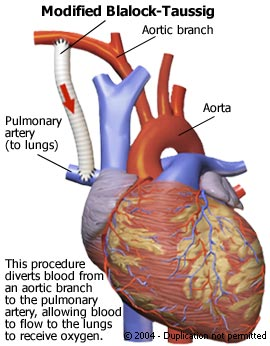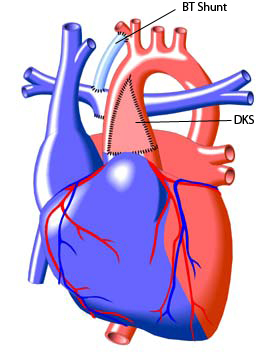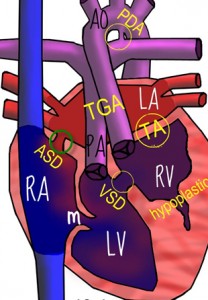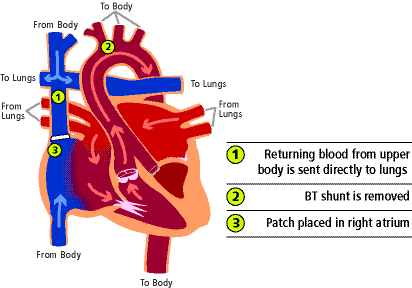Treatment of TA/l-TGA
There are a few different treatment options. Families will make their decisions based on overall fetal development, heart function and capability, and quality of life. Before about 25 years ago, nearly all single ventricle congenital heart defects were 100% fatal. Upon development of surgical procedures and their refinement, success rates have risen to 75-90+%. Options include:
1. Pregnancy termination – not remotely an option for us
2. Compassionate Care after birth – no surgical intervention, just support for the infant while “nature takes its course”
3. Heart Transplant – difficulty in obtaining a donor heart for an infant and the life-long possibility of rejection
4. Series of 3 operations with the end result achieving Fontan Circulation – most often recommended
With Evan’s other physical development and the functioning condition of the working parts of his heart, the evidence indicates he will be a strong candidate for surgery. (YAY!)
Surgery
As described on the Normal Heart vs. Evan’s Heart page there are several different issues going on at the same time. The goal is to ensure that he’s getting appropriate amounts of blood to his body and to his lungs. This will require at least three surgeries and several procedures can be performed at each surgery.
First surgery: The stage I Norwood procedure, Damus-Kaye-Stansel procedure, and an atrial septectomy
 Stage I Norwood procedure: Performed within a few weeks of birth, depending on the baby’s physiology. This procedure serves to make the right ventricle the main pumping chamber for blood flow to the body. Depending on the anatomy, the aorta may be made larger to increase blood flow to the body. A connection is made to enable blood traveling through the aorta towards the body to “shunt” through this connection and flow into the pulmonary artery to receive oxygen. This may be accomplished with a modified Blalock-Taussig (BT) shunt or a Sano modification procedure. In Evan’s case the BT shunt was used and is a GoreTex tube attached at one end to the pulmonary artery and at the other to the right subclavian artery. The size of this shunt is carefully determined so that the right amount of blood goes to the lungs. This shunt will be outgrown in 4-6 months and is the tipping point for the second surgery. The infant will still have some degree of cyanosis since oxygen-poor (blue) blood from the right atrium and oxygen-rich (red) blood from the left side of the heart mix and flow through the aorta to the body.
Stage I Norwood procedure: Performed within a few weeks of birth, depending on the baby’s physiology. This procedure serves to make the right ventricle the main pumping chamber for blood flow to the body. Depending on the anatomy, the aorta may be made larger to increase blood flow to the body. A connection is made to enable blood traveling through the aorta towards the body to “shunt” through this connection and flow into the pulmonary artery to receive oxygen. This may be accomplished with a modified Blalock-Taussig (BT) shunt or a Sano modification procedure. In Evan’s case the BT shunt was used and is a GoreTex tube attached at one end to the pulmonary artery and at the other to the right subclavian artery. The size of this shunt is carefully determined so that the right amount of blood goes to the lungs. This shunt will be outgrown in 4-6 months and is the tipping point for the second surgery. The infant will still have some degree of cyanosis since oxygen-poor (blue) blood from the right atrium and oxygen-rich (red) blood from the left side of the heart mix and flow through the aorta to the body.
Damus-Kaye-Stansel Procedure: Performed, in this case, at the same time as the Norwood. The purpose of this procedure is to combine the flows from the aortic and pulmonary valve into a single flow into the aorta. The attachment of the pulmonary valve to the pulmonary artery is severed and sealed. All blood being pumped by the heart is diverted into the aorta by cutting open the aorta right above the aortic valve and expanding the opening to encompass both aortic and pulmonary valves. Blood flow is maintained to the lungs through the use of the BT shunt inserted as part of the Norwood procedure. Infants will still be cyanotic (low blood oxygen level) as oxygen rich and oxygen poor blood are still mixing in the heart and being pumped to the body.
Atrial septectomy: this procedure is to ensure adequate flow through the atrial septal defect (ASD), the only pathway by which oxygenated blood passes from the atria to the ventricles with this heart condition. Both sides of the wall surrounding the ASD are are trimmed away making the whole as large as possible. If this is not completed it’s possible that this hole can become smaller or even close.
Second surgery: The hemi-Fontan or Glenn
Performed at 4-6 months of age. In this operation, the Blalock-Taussig shunt is removed, and the superior vena cava (the large vein that brings oxygen-poor blood from the head and arms back to the heart) is connected to the right pulmonary artery in what is called a Glenn shunt. Blood from the head and arms passively flows into the pulmonary artery and proceeds to the lungs to receive oxygen. However, oxygen-poor (blue) blood returning to the heart from the lower body through the inferior vena cava will still mix with oxygen-rich (red) blood in the left heart and travel to the body, so the child will remain mildly cyanotic. This operation helps create some of the connections necessary for the final operation.
Third surgery: The Fontan procedure.
Performed at 18-36 months of age. This operation allows all the oxygen-poor (blue) blood returning to the heart to flow into the pulmonary artery, greatly improving the oxygenation of the blood. The Glenn shunt, connecting the superior vena cava to the right atrium, is left in place. A second connection is made directing blood from the inferior vena cava to the right pulmonary artery. This connection can be created in slightly different variations, depending on the method your child’s surgeon prefers, and what is best for your child. After this final step, the baby is no longer cyanotic.
Outlook
The Norwood procedure poses the highest risk for poor outcomes and death. Some specialized centers where a greater number of procedures are performed have achieved survival rates of 75% or better. The recovery period in the hospital following the Norwood operation is often unpredictable and complicated, averaging about 3 to 4 weeks. A small percentage of patients who leave the hospital may continue to experience significant problems in the first months of life. In some cases, this first surgery is not necessary.
If a child reaches the time for the second operation without major complications, the survival through the Glenn and Fontan operations are much better, exceeding 90 percent with current methods.
Almost all children will continue to need some cardiac medications to maximize the efficient function of their heart, and all will require regular periodic follow-up visits with their cardiologist to evaluate their cardiac function and detect late complications such as arrhythmias.





